The Transition from Academic Physics to the Wider World
Robert L. Kleinberg, Schlumberger
Introduction
It is universally acknowledged that strong educational systems are among the principal foundations of modern societies. Science education is particularly prized, as it is perceived there is an intimate connection between it and the technological progress that is a hallmark of prosperous nations with improving standards of living.
In many cases, the connection between academic science and the economic engines of the broader society are reasonably clear. The paths from academic studies of semiconductor physics or polymer physics to corresponding industrial enterprises are reasonably direct. Yet one must ask, how exactly do studies of high energy physics or astrophysics connect to the concerns of wider society? No one would propose that we confine physics education to fields viewed as practical. Yet we owe it to physics students to give them some idea of how the hard work of undergraduate and graduate physics connects to their future in the outside world.
As the 2018-2019 American Physical Society Distinguished Lecturer on the Applications of Physics, I have had the opportunity to visit a wide variety of academic physics departments. Faculty headcounts have ranged from six to well over sixty, with proportionate populations of undergraduate physics majors and physics graduate students. The most rewarding aspect of these visits has been roundtable discussions with students. I was looking for “directionless” students, and I found no shortage of them.
Not that the students I talked to were disillusioned with physics or aimless in their studies. Far from it. They talked about their coursework and research projects with evident enthusiasm. But many had only a vague notion of what they might do with their education once they had finished their studies. This is not surprising. According to a recent letter to Physics Today [1], a professor at a major research university supervises an average of fifteen Ph.D. students in the course of his career, far above the replacement rate. Between 2002 and 2016 the number of physics faculty hired by all degree-granting schools varied between 230 to 360 per year [2] a period during which between 1100 and 1850 physics Ph.D. degrees per year were granted from American universities [3]. Thus although about half of students express an interest in an academic career, only about 20% will be able to pursue one.
For the other 80%, the course is far from clear. It is surprising but true that many physics students have never met a physicist outside of the university environment. We often speak of the lack of role models for women and minorities in physics, and indeed this is a real concern. But the fact is that few physics students, male or female, majority or minority, have role models that help them envision how their careers might evolve in the future.
The APS Distinguished Lecturer program is a small but helpful step toward mitigating this problem. Each lecturer decides what message he will carry forth during his or her one year tenure. One recent lecturer highlighted the fragile mental health status of physics graduate students [4], a startling thesis that nonetheless has the ring of truth.
My approach was more conservative: a fully worked example of how one Ph.D. physicist made the transition from studying the exotic physics of superfluid helium-3, which exists below three millikelvin, to designing geophysical instrumentation that could survive and operate ten kilometers below the surface at temperatures as high as 175ºC. Hence the title: “mK to km: How Millikelvin Physics is Reused to Explore the Earth Kilometers Below the Surface”.
One must first ask why I made this career choice. I certainly did not go to graduate school with the intent of learning to design geophysical instrumentation. However, my years in graduate school coincided with the oil embargoes of the 1970s. The trauma of long lines of automobiles outside of gasoline stations generated pressure for improvement and innovation in the provision of energy.
Such was the milieu when I finished graduate school in 1978. At forty years remove, it may seem strange that increasing the supply of fossil fuels was widely seen as an indispensable element of continued national security and economic well-being. But the study of fossil fuel emissions on climate was in an early phase, and advances in renewable energy and energy storage were still in the future. So I joined the petroleum industry, with the explicit goal of finding ways to make the extraction of oil from the earth more efficient.
Surprisingly, my graduate school training in millikelvin physics stood me in good stead in achieving this goal. To illustrate my transition from esoteric academic studies of superfluidity in liquid helium-3 to very practical inventions used to improve oil production, I present two case studies: one device that measures which way the wind was blowing ten million years ago, and another that measures the sizes of micrometer-scale interstices in porous media.
Electrical Conductivity Imaging of the Borehole
As will be shown below, the problem of measuring the direction of paleoclimatic winds reduces to a simpler and more generally useful measurement of the magnitude (“dip”) and orientation (“strike”) of layers of rock in the subsurface. Indeed, geometric measurements of sedimentary layers within the earth is fundamental to the delineation of oil and gas reservoirs in the subsurface.
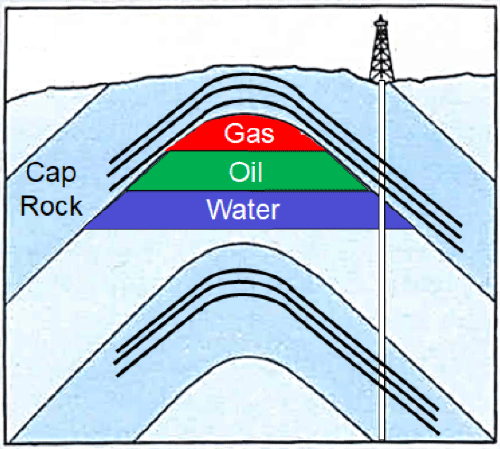
Figure 1. Archetypal oil and gas reservoir. Buoyant hydrocarbons are trapped beneath a dome of impermeable cap rock. Black lines mark strata within major (shaded) rocks units.
Figure 1 is a cartoon of an archetypal oil and gas reservoir. Oil and gas originate deep within the earth, where organic matter, co-deposited with inorganic sediments, is thermally converted to light hydrocarbons. These hydrocarbons are less dense than water, which is ubiquitous in the subsurface, and therefore rise through the permeable rock column toward the surface. In favorable circumstances, they are trapped under a dome of impermeable cap rock. Otherwise they continue to the surface where they appear as oil or gas seeps, and are quickly oxidized in the atmosphere or ocean.
A principal goal of exploration geophysics is to find these domes. Then an exploratory well is drilled, but these wells often drill into underlying water-filled rock, as suggested by the figure. In order to drill into oil and gas deposits, subsequent wells must be drilled toward the top of the structure, determined by measuring the dip and strike of layers of sedimentary rock, shown as black curves in Figure 1.
Geologists routinely measure dip and strike at rock outcrops, but it is daunting to do so from within a 20 cm diameter borehole, several kilometers inside the earth, with instrumentation confined to the interior of a pressure housing able to withstand hydrostatic pressures of 140 MPa. Rather than putting a sample into a machine, the usual physics modality, the machine must be put into the sample, which is in fact the earth. Moreover, to achieve commercial viability, borehole measurement apparatus must satisfy a long list of engineering requirements, outlined in Box 1.

Few physics students leave their undergraduate or graduate education having had experience in building borehole instrumentation. Nonetheless, the recent graduate is far from helpless. Measuring the geometry of rock layers in a borehole depends on finding physical properties that are likely to vary from layer to layer. At outcrops, visual clues such as color and texture are often adequate. In the borehole, properties such as the speed of sound or electrical conductivity are likely to be more useful [5]. The electrical conductivity of fluid-saturated sedimentary rocks commonly varies between 0.001 S/m and 1 S/m, thus making conductivity an interesting measurement target.
Then the question becomes how to measure electrical conductivity outside of a pressure housing at 175º C.I took as inspiration the apparatus I built to measure the temperature of helium-3 below three millikelvin, shown in Figure 2 [6]. At left is an expanded view of the of the heat flow tower, within which is a 10 mg pellet of cerium magnesium nitrate (CMN), a paramagnetic salt used to measure the temperature of helium. CMN obeys the Curie-Weiss Law, which relates paramagnetic susceptibility to absolute temperature, with two calibration constants. The susceptibility is measured by positioning the pellet in one leg of a balanced-secondary mutual inductance coil set. The in-phase signal is proportional to susceptibility; the quadrature signal is rejected by phase sensitive detection.

Figure 2. Apparatus used to measure the thermal conductivity of helium-3 at very low temperatures. At left is an expanded view of the heat flow tower, within which is a small pellet of cerium magnesium nitrate (CMN), a paramagnetic salt used to measure the temperature of helium [6].
To make an electrical conductivity measurement of rock surrounding a borehole, I turned the mutual induction concept inside out [7], see Figure 3. A single-turn primary loop generates a primary magnetic field which drives currents in the rock formation. These currents in turn generate a secondary magnetic field with unequal fluxes in the single-turn receiver loops, which are symmetrical with respect to the primary coil but not with respect to ground currents in the rock formation. The net quadrature signal is directly proportional to conductivity. The in-phase signal, which includes the magnetic susceptibility of the formation, is uninteresting in this context and is rejected.
In order to withstand the rigors of field deployment, the sensor had to be enclosed in a metal housing, with the side of the sensor closest to the borehole wall protected by a tough non-conductive ceramic face plate, see Figure 4. Metals generally have conductivities in the range of 107 S/m, many orders of magnitude greater than the most conductive salt-water-saturated rock. A naïve expectation might be that signal from the metal would overwhelm the signal from the rock formation, but this is not the case. The metal acts as a mirror, contributing nothing to the loss (conductivity) signal, but unbalancing the primary magnetic flux threading the two receiver loops. In order to restore the balance, the spacings between the primary and individual secondary loops are adjusted minutely. Residual imbalance is included in the discarded in-phase (permeability) signal.

Figure 3. Concept for electrical conductivity measurement of a rock formation surrounding a borehole. The primary loop is energized by an alternating current source I. Symmetrically placed secondary loops are unbalanced by the presence of the conductive rock formation. The voltage VL, measured across impedance ZL, is linearly proportional to the conductivity of the formation [7].
a 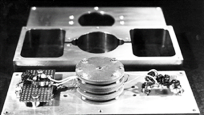
b 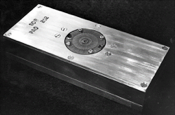
Figure 4 (a) Exploded view of conductivity sensor and associated electronic circuits in a brass housing. (b) Assembled laboratory prototype sensor and housing.
The hardware shown in Figure 4 is clearly not waterproof, and fails to satisfy many other specifications included in Box 1. Nonetheless, it is an electromagnetically correct model, was used in a battery of laboratory tests, and showed that there were no barriers to the construction of a field-worthy instrument.
The story thus far has been told from the point of view of the experimental physicist, but theory and mathematical modeling played equally important roles. Alternative designs are evaluated, dimensions and materials optimized, and performance predicted more quickly and easily on the computer than in hardware [8].
To measure dip and strike from within a borehole, four such sensors are mounted on spring loaded arms that press the sensors against the borehole wall at 90º azimuths, as shown in Figure 5. The arms, mounted on a central mandrel, are pulled up the borehole on multiconductor cable, which transmits power and telemetry.
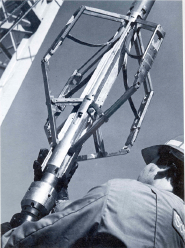
Figure 5. Four sensors, mounted on spring loaded arms that press them against the borehole wall, are pulled up the well to make the measurement. [Schlumberger]
The measurement method is sketched in Figure 6. The boundary between dipping rock beds, having contrasting electrical conductivities σ1 and σ2, is detected by the four sensors at different depths in the borehole. The four electrical records of conductivity vs depth (of which only two are shown here) are compared to determine the dip (angle from horizontal) and strike (the azimuth of the dipping rock body, assumed to be planar).
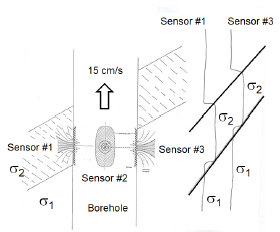
Figure 6. Method of measuring dip and strike of a layered sedimentary formation. The boundary between dipping rock beds, having contrasting electrical conductivities σ1 and σ2, is detected by the four sensors at different depths in the borehole. The four electrical records of conductivity vs depth (of which only two are shown here) are compared to determine the dip and strike.
The direction of the wind is ephemeral, and would seem to be an unlikely product of the measurement of rock properties deep inside the earth. Nonetheless, wind direction is encoded in the internal structure of sand dunes. Sand is blown up the windward side of the dune, leading to periodic avalanches on the leeward side, as shown in Figure 7. Each avalanche forms a distinct layer, which given appropriate environmental conditions can be fossilized. Eventually, the dune field can be preserved by burial. Thus the prevailing direction of the wind is encoded in the subtle layering of the dune, corresponding to the down-dip direction of the rock layers.

Figure 7. Wind-driven sedimentation in sand dunes.
Once covered by cap rock, dunes make excellent oil reservoirs, due to their high porosity and permeability to fluid flow. Because dune fields tend to elongate in the direction of the wind, once oil is found in a sand dune environment, it is a better bet to drill the next well upwind or downwind, rather than across the wind direction. This method has been found to have commercial value [9].
Pore Size Distribution of Sedimentary Rock
Despite suggestive nomenclature, and the impression some might have from exposure to children’s fiction [10], oil reservoirs are not large subterranean lakes. Oil and gas are found in micrometer-scale interstices of sedimentary (more rarely, igneous or metamorphic) rock formations. Figure 8 is a micrograph of a quarried rock, similar to rock found in very high grade petroleum reservoirs. One property of an excellent reservoir rock is a substantial volume fraction of pore space (“porosity”). Good reservoirs usually have porosities around 0.3, i.e. 30% of the rock is available to be filled with fluids. The other desirable property is permeability to fluid flow. Permeabilities of oil and gas reservoirs range over eight orders of magnitude [11]; adequate flow rate is essential to economic viability.
Roughly speaking, the permeability is proportional to the square of pore size. A number of empirical and semi-empirical correlations have been established [12], all of which require some knowledge of pore size. Unless one brings samples of rock to the surface for laboratory investigation – an expensive and time-consuming process – pore size is very difficult to estimate from standard borehole measurement methods. Nuclear magnetic resonance has proved to be the most reliable method of determining pore size.

Figure 8. Micrograph of sandstone quarried in Berea, Kentucky. White areas are sand grains, black areas are clay particles, and blue areas are pore space, which can be occupied by oil, water, or natural gas. The permeability to fluid flow, i.e. the rate at which liquids and gases can flow from the rock to the wellbore, is proportional to the square of the pore size.
At the simplest level, the connection between magnetic resonance and pore size is illustrated in Figure 9. Panel 1: A static magnetic field, B0, polarizes nuclei in fluid molecules residing in porous media. Panel 2: A pulse of oscillating magnetic field, B1, reorients the nuclear spins into the plane perpendicular to B0. Panel 3: The orientation of a nuclear spins is largely unaffected by rotational and translational motions of the molecule in which it resides. Panel 4: Upon contact with a magnetic ion on a solid grain surface the spin can relax back to its low-energy state parallel to B0. The smaller the pore, the less time it takes for a fluid molecule to diffuse to a grain surface. A quantitative treatment of this phenomenon shows that the nuclear magnetic relaxation rate is proportional to the local surface-to-volume ratio of the pore space [12].

Figure 9. Simplified explanation of connection between magnetic resonance measurements and pore size.
Thus the magnetic resonance measurement requires a constant static magnetic field, B0, and a pulsed oscillating magnetic field, B1, perpendicular to B0. These conditions are easily satisfied in the laboratory, where the sample, which might be a human being, is inserted into the apparatus. It is less obvious how to implement the measurement when the sample is external to the sources of the fields, particularly because the signal to noise ratio is proportional to the square of B0, and this field drops off rapidly with distance from the source.
This problem has been solved in a number of different ways [13]. The solution I and my colleagues found is shown in Figure 10. The apparent simplicity of the design belies the myriad complications encountered in its development [14,15].
Because spectrometers operating at the sensor’s operating frequency of 2 MHz were not commercially available, one was designed and built as part of the project, incorporating a number of novel circuits [16]. Low signal to noise, strict performance specifications, and the necessity of suppressing spin dynamics errors forced us to invent a new pulse sequence [17]. Significant theoretical and experimental efforts were needed to understand the magnetic resonance properties of fluids in porous rock, culminating in a comprehensive microscopic theory [18,19].
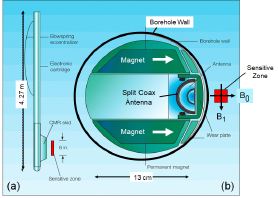
Figure 10. Borehole nuclear magnetic resonance apparatus. (a) Side view of borehole instrument, showing electronics cartridge (top) and sensor section (“CMR skid”) (bottom). The zone of sensitivity (red rectangle) is outside the apparatus. (b) Cross-sectional view of sensor. Permanent magnets generate a constant magnetic field, B0, outside of the borehole, several centimeters inside the rock formation. The split coax antenna generates a pulsed oscillating field, B1, which is perpendicular to B0 in the sensitive zone.
More than thirty years after its invention, the borehole nuclear magnetic resonance measurement continues to prove its utility in ways the inventors could not have foreseen. For example, it has been found to be useful for other applications where conditions excluded the use of conventional laboratory equipment. One such application was an assay of methane hydrate generated in porous rock at the seafloor offshore Monterey, California. For this purpose, modified borehole NMR apparatus was mated with a remotely operated submersible vehicle [20,21], see Figure 11. In another deployment, the apparatus was used to characterize permafrost on the Arctic coast of Alaska [22].

Figure 11. The author (kneeling) installing modified borehole nuclear magnetic resonance apparatus on a remotely operated submersible vehicle at the Monterey Bay Aquarium Research Institute.
Conclusion
Few physics students are able to follow in the footsteps of their academic advisors, but few have a clear idea of the opportunities open to physicists elsewhere. Physicists are not usually hired to continue their thesis work, and are not generally hired to perform routine technical tasks. They are expected to be innovators. Indeed the physicist’s tool box is a rich one, including theory, mathematical modeling, instrument design, and data processing.
Dynamic economic systems respond to societal needs by confronting and solving problems. Incumbents ramp up research and development efforts [23] while entrepreneurs (often physicists themselves) start new enterprises. In such circumstances, there is rarely an adequate supply of experienced workers whose skills exactly match emerging needs. Employers look for smart, adaptable candidates who can bring technical skills and an instinct for innovation to a novel set of problems. Innovation starts at the employment interview, where the candidate needs to show how his or her experience, often in a very esoteric field of study, intersects with the priorities of the prospective employer.
Historically, physicists have become leaders in fields seemingly remote from their textbooks, calculations, and labs. Molecular biology was revolutionized by physicists [24,25], and physicists have taken a leading role in bringing quantitative methods to financial markets [26]. Neither biology nor finance are standard elements of the physics curriculum. Today’s world does not just reward adaptability, it demands it, and few professions provide better preparation for the challenges of the future — whatever they may be — than physics.
Acknowledgements
I owe an enormous debt of gratitude to my colleagues and collaborators over the years. Here I only cite those with whom I worked on the projects mentioned in this article. At the University of California, San Diego: Richard Johnson, Richard Webb, and John C. Wheatley. At Schlumberger: Douglas Griffin, Weng Cho Chew, Brian Clark, Apo Sezginer, Masafumi Fukuhara, Lawrence Latour, Partha Mitra, Suhail Farooqui, Imelda Foley, Charles Flaum, and Christian Straley. At the Monterey Bay Aquarium Research Institute: Peter Brewer, George Malby, and James Yasinowski.
References
[1] T. Christensen, “Rebutting Remarks on Feynman and Wheeler”, Physics Today 71(9), 1-13 (2018)
[2] American Institute of Physics, Number of Faculty Hired by Physics Departments, Fall 2017 https://www.aip.org/sites/default/files/statistics/physics-trends/fall17-faculty-hired-p.pdf
[3] American Institute of Physics, Number of Doctorates Earned in Physics, Classes 1972 through 2017, 15 October 2018
https://www.aip.org/statistics/data-graphics/number-doctorates-earned-physics-classes-1972-through-2017
[4] R. Kleinberg, R. Tromp, T. Brintlinger, C. Bailey, The APS Distinguished Lectureship on the Applications of Physics, APS News, January 2018
https://www.aps.org/publications/apsnews/201801/lectureship.cfm
[5] D.V. Ellis, J.M. Singer, Well Logging for Earth Scientists. Berlin: Springer (2007)
[6] R.T. Johnson, R.L. Kleinberg, R.A. Webb, J.C. Wheatley, Journal of Low Temperature Physics, 18, 501-517 (1975)
[7] R.L. Kleinberg, W.C. Chew, D.D. Griffin, "Noncontacting Electrical Conductivity Sensor for Remote, Hostile Environments", IEEE Transactions on Instrumentation and Measurement, 38, 22-26 (1989)
[8] W.C. Chew, R.L. Kleinberg, Theory of Microinduction Measurements, IEEE Transactions on Geoscience and Remote Sensing, 26, 707-718 (1988)
[9] Schlumberger, Oil-Base Mud Dipmeter Tool, Publication M-090195, June 1987
[10] J. Verne, A Journey to the Center of the Earth, Classics Illustrated No. 138, Gilberton (1957)
[11] R.L. Kleinberg, J. Boak, Unconventional Fossil Fuels Nomenclature, Oklahoma Geology Notes, 77 (3) 20-25 (July 2017)
http://ou.edu/content/dam/ogs/documents/geologynotes/GN-V77N3.pdf
[12] R.L. Kleinberg, Nuclear Magnetic Resonance, in P.-z. Wong, ed., Experimental Methods in the Physical Sciences, Volume 35: Methods in the Physics of Porous Media, Academic Press, 1999
[13] Special Issue: The History of NMR Well Logging, Concepts in Magnetic Resonance, 13(6), 340-411 (2001)
[14] R.L. Kleinberg, A Sezginer, D.D. Griffin, M. Fukuhara, Novel NMR Apparatus for Investigating an External Sample, Journal of Magnetic Resonance, 97, 466 (1992)
[15] A. Sezginer, D.D. Griffin, R.L. Kleinberg, M. Fukuhara, D.G. Dudley, RF Sensor of a Novel NMR Apparatus, Journal of Electromagnetic Waves and Applications, 7, 13 (1993)
[16] D.D. Griffin, R.L. Kleinberg, M. Fukuhara, Low Frequency NMR Spectrometer, Measurement Science and Technology, 4, 968 (1993)
[17] A. Sezginer, R.L. Kleinberg, M. Fukuhara, L.L. Latour, "Very Rapid Simultaneous Measurement of Nuclear Magnetic Resonance Spin-Lattice Relaxation Time and Spin-Spin Relaxation Time", Journal of Magnetic Resonance, 92, 504 (1991)
[18] R.L. Kleinberg, W.E. Kenyon, P.P. Mitra, "Mechanism of NMR Relaxation of Fluids in Rocks", Journal of Magnetic Resonance, A108, 206 (1994)
[19] I. Foley, S.A. Farooqui, R.L. Kleinberg, "Effect of Paramagnetic Ions on NMR Relaxation of Fluids at Solid Surfaces", Journal of Magnetic Resonance A123, 95 (1996)
[20] R.L. Kleinberg, C. Flaum, C. Straley, P.G. Brewer, G.E. Malby, E.T. Peltzer, G. Friederich and J.P. Yesinowski, Seafloor nuclear magnetic resonance assay of methane hydrate in sediment and rock, Journal of Geophysical Research 108(B3): 2137 (2003); doi:10.1029/2001JB000919
[21] R.L. Kleinberg, C. Flaum, D.D. Griffin, P.G. Brewer, G.E. Malby, E.T. Peltzer and J.P. Yesinowski, Deep sea NMR: Methane hydrate growth habit in porous media and its relationship to hydraulic permeability, deposit accumulation, and submarine slope stability, Journal of Geophysical Research 108(B10): 2508 (2003); doi:10.1029/2003JB002389
[22] R.L. Kleinberg and D.D. Griffin, NMR measurements of permafrost: Unfrozen water assay, pore scale distribution of ice, and hydraulic permeability of sediments, Cold Regions Science and Technology 42, 63-77 (2005)
[23] R.L. Kleinberg, M.N. Fagan, Business Cycles and Innovation Cycles in the U.S. Upstream Oil & Gas Industry, submitted for publication
[24] R. Holliday, Physics and the origins of molecular biology, Journal of Genetics, 85, 93-97 (2006)
[25] A. Jogalekar, Physicists in Biology; And Other Quirks of the Genomic Age, The Curious Wavefunction Blog, Scientific American (2012) https://blogs.scientificamerican.com/the-curious-wavefunction/physicists-in-biology-and-other-quirks-of-the-genomic-age/
[26] Anonymous, Net gains, Nature Physics 9, 119 (2013)
https://doi.org/10.1038/nphys2588
https://rdcu.be/bfHRL
These contributions have not been peer-refereed. They represent solely the view(s) of the author(s) and not necessarily the view of APS.
